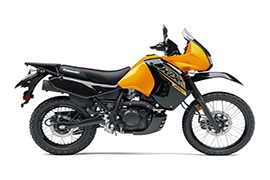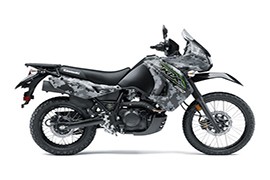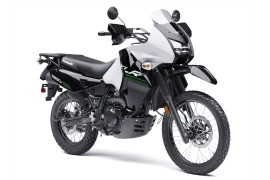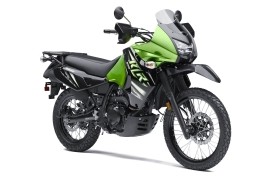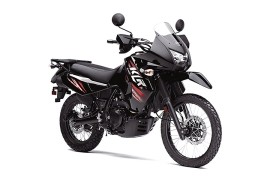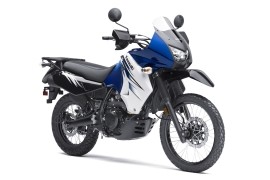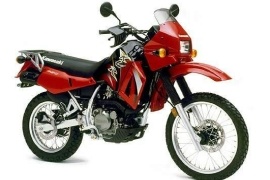KAWASAKI KLR 650 Models/Series Timeline, Specifications & Photos
First production year: 2000
In 2018, the Japanese motorcycle manufacturer released the KLR650, an adventure bike that offered great performance on almost every terrain, such as sand, dirt, forest roads, and even on paved roads but also delivered comfort and great fuel efficiency.
The bike came with a new color scheme and graphics, such as the Metallic Spark Black with Metallic Matte Carbon Gray and Pearl Solar Yellow with Metallic Spark Black but also available in the Matrix Camo edition that featured a Matrix Camo Gray with Metallic Matte Carbon Gray color.
As versatile as the bike itself were the genuine Kawasaki KLR-branded saddlebags that featured a matte black rubberized finish, which made them durable and best suited for everyday use around town or long trips.
For suspension, the bike packed a 41 mm air-adjustable fork on the front that provided 200 mm of wheel travel and a Uni-Trak linkage rear shock absorber that featured a five-way preload and four-way rebound adjustability and offered almost 190 mm of wheel travel.
Also, the bike offered decent wind protection with its frame-mounted bodywork that included a tall windshield and large shrouds, which protected the rider and passenger from the elements.
In the performance department, the 2018 Kawasaki KLR650 had its heartbeat set by a 651cc four-stroke single-cylinder liquid-cooled engine that featured a double-engine balancer that provided smooth running from the idle to the redline.
As for the power figures, the bike delivered an output power of 42 hp with a peak at 7,000 rpm and 47 Nm (35 lb-ft) of torque available at 5,000 rpm, converted into motion by a five-speed manual transmission.
For 2017, Kawasaki launched two KLR650 models, such as the standard KLR650 and the KLR650 Camo edition, a series of dual-purpose motorcycles designed for adventures either on-road or off-road and came in a color combination that enhanced its appearance.
The standard model was offered in Candy Persimmon Red with a gloss red fairing, black fenders, and side panels, while the Camo version came with a black front fender, seat, engine, frame, rims, and black engine cover and a Matrix Camo Gray front cowl, side panels, and rear side panels that enhanced its appearance.
The KLR650 Camo offered great ergonomics with its seat that featured a narrow front section with a rounded profile for easier reach to the ground, and towards the rear, it had a slightly tapered profile that offered a wider platform for better comfort for the rider and passenger.
The 2017 Kawasaki KLR650 Camo model featured a semi-double cradle high-tensile steel frame made of round sections and a removable rear subframe that provided better access to the rear shock absorber, airbox, and carburetor.
As for power, the Camo edition packed the same engine as its standard siblings, such as a 651cc four-stroke single-cylinder liquid-cooled engine that featured a double-engine balancer for smooth running from idle to the redline and a power output of 42 hp at 7,000 rpm and 47 Nm (35 lb-ft) of torque at 5,000 rpm.
For braking performance, the bike packed a dual-piston caliper with a 280 mm petal-styled disc on the front and a 240 mm petal-styled disc with a single-piston caliper on the rear.
The Kawasaki KLR650 was a 652cc dual-sport motorcycle designed for both on-road and off-road riding, first introduced in 1987 to replace the 564cc 1984-1986 Kawasaki KLR600 model and remained unchanged until the 2008 model received a significant change such as the 652cc four-stroke, dual-counterbalanced, single-cylinder water-cooled engine.
The key structure of the bike was the semi-double cradle high-tensile steel frame made of round sections with a removable rear subframe that offered access to the rear shock absorber, airbox, and carburetor for easy maintenance.
The bodywork included a large fairing that provided great wind protection, a dual-bulb headlamp that offered great night lightning, a taillight, a parking light, and high-mounted turn signals that improved visibility at night or poor visibility conditions.
Also, the bike featured an easy-to-read instrument panel mounted on the frame that included a large-face speedometer, tachometer, odometer, trip meter, and water temperature gauge, and a 17 amps alternator output with 36 watts of power that handled the headlight, the add-on grip heaters, and other accessories.
The 2015 Kawasaki KLR650 had its heartbeat set by a four-stroke single-cylinder liquid-cooled engine that delivered an output power of 42 hp with a peak at 7,000 rpm and 47 Nm (35 lb-ft) of torque available at 5,000 rpm.
All the power was converted into motion by a five-speed manual transmission linked through a sealed chain to the rear wheel, which was composed of four mm spokes that provided stiffness, enhanced handling performance, and improved steering response.
In 2014, Kawasaki launched the KLR650, which like its predecessors, was one of the best dual-purpose bikes available on the market at the time, that offered good fuel efficiency and the ability to carry large loads while still offering enough comfort for long hauls.
Just like any respectable off-roader, the Kawasaki KLR650 needed a set of cable suspensions, so it came with a 41 mm fork on the front that provided 200 mm of wheel travel and a Uni-Trak five-way preload-adjustable and four-way rebound adjustable shock absorber on the rear that offered 190 mm of wheel travel.
The bike was designed from the beginning as a fuel-efficient machine, rugged, and capable of carrying enough load while offering effective wind protection for long journeys, which made it an unbeatable value for those riders who were seeking adventure at every corner.
As for the braking performance, the model packed a tow-piston caliper that squeezed a 280 mm petal-style disc on the front wheel and a 240 mm disc with a single-piston caliper on the rear, while combined with the suspension package boosted the bike's performance without messing with its versatile off-road capabilities.
The 2014 Kawasaki KLR650 took its thrust from a 651cc four-stroke single-cylinder liquid-cooled engine that delivered an output power of 42 hp with a peak at 7,000 rpm and 47 Nm (35 lb-ft) of torque available at 5,000 rpm, converted into speed by a five-speed manual transmission linked to the rear wheel with a chain final drive.
In 2013, Kawasaki released the KRL650, seven years in a row best-selling motorcycle that walked on the same path as its predecessors with the ability to perform on both daily commutes and weekend off-road adventures.
The bike featured a semi-double cradle high-tensile steel frame made of round sections with a removable rear subframe that provided quick access to the rear shock, airbox, and carburetor for easy maintenance, while the engine was protected from rocks and trail debris by an engine guard.
In addition, the motorcycle featured a large fairing that provided great wind protection, an easy-to-read instrument panel mounted on the fairing with a large-face speedometer, a tachometer, an odometer, a trip meter, a water temperature gauge, and a urethane seat foam that offered all-day comfort.
For suspension, the 2013 Kawasaki KRL650 packed a 41 mm fork on the front that offered 200 mm of wheel travel with a high-mounted front fender for off-road situations and a Uni-Trak five-way preload-adjustable and four-way rebound adjustable shock absorber on the rear that provided 190 mm of wheel travel.
As for power, the Kawasaki KRL650 took its thrust from a 651cc four-stroke single-cylinder liquid-cooled engine with a compact combustion chamber that offered low-end torque and enough power across the rpm range and a secondary air system that reduced emissions.
As for the power figures, the bike delivered an output power of 42 hp with a peak at 7,000 rpm and 47 Nm (35 lb-ft) of torque available at 5,000 rpm.
In 2012, Kawasaki launched the KLR650, the best-selling dual-sport motorcycle for seven years in a row and a bike that could handle all types of terrain, such as sand, dirt, forests, and pavement, with its single-cylinder engine that also delivered incredible fuel efficiency.
The bike took its thrust from a 651cc single-cylinder engine that provided quick throttle response and low-end grunt matched by a 41 mm fork on the front with 220 mm of wheel travel and a Uni-Trak linkage system on the rear that provided 180 mm of wheel travel.
As for the braking performance, the bike packed a 280 mm disc with a two-piston caliper on the front and a 240 mm disc with a single-piston caliper on the rear, which, combined with the suspension package, boosted the performance without lowering its versatile off-road capabilities.
Also, the bike was a worthy touring companion with its large 30-liter fuel tank that allowed long touring journeys between fill-ups and a rear luggage rack fitted with a tail bag. As for wind protection, the frame-mounted bodywork, a tall windscreen, and large shrouds did the job, while comfort was achieved by the seat design with plush urethane foam.
In the performance department, the 2012 Kawasaki KLR650 had its heartbeat set by a 651cc four-stroke single-cylinder liquid-cooled engine that delivered an output power of 42 hp with a peak at 7,000 rpm and 47 Nm (35 lb-ft) of torque available at 5,000 rpm, converted into speed by a five-speed manual transmission that spun the rear wheel through a chain drive.
The Kawasaki KLR 650 was a dual-sports motorcycle powered by a 652cc single-cylinder liquid-cooled engine and intended for both paved and unpaved roads. The bike was introduced in 1987 as a replacement for the Kawasaki KLR 600.
The bike was manufactured over three generations, from 1987 to 2007, 2008 to 2018, and from 2022 until the present (2023). The motorcycle received its first significant revision in 2008, mainly including comfort and quality improvements.
Some of the significant upgrades included new trims, fairing, turn signals, a new instrument panel, and gauge cluster, redesigned handlebar switches, a dual-piston caliper on the rear, an upgraded alternator, an increased fork diameter, a new swingarm, larger petal brake discs, and an increased radiator capacity.
Several minor improvements included a dual-beam headlight, a larger luggage rack, a firmer seat, and larger wire-spoke wheels. All these upgrades made the bike 7.3 kg (16 lbs) heavier than its predecessor.
The bike was out of production for three years, but it was back in business in 2022 with more upgrades, such as a fuel injection system instead of a carburetor, optional ABS, new bodywork, new trims and fairings, an adjustable windscreen, an LCD cluster, larger brake discs on the front, and an upgraded alternator.
The bike also gained minor changes, like a new diameter for the exhaust pipe, revised cam profiles, and a new catalyzer. Compared to the previous model, the new machine was 11 kg (24 lb-ft) heavier.
The Kawasaki KLR 650 was a dual-sports machine that debuted in 1987, intended to handle both paved and unpaved roads. The bike was manufactured over three generations, from 1987 to 2007, 2008 to 2018, and 2022 until the present (2023).
The bike replaced the 564cc Kawasaki KLR600 manufactured from 1984 to 1986 and remained almost unchanged until it featured the first rear revision in 2008. The second major revision occurred in 2022, with a fuel injection system and ABS.
In 2000, the Japanese motorcycle manufacturer launched the Kawasaki KLR 650 USA Model, a dual-sports motorcycle that packed the same performance, technical, and visual features as previous models without any modification whatsoever.
The motorcycle was built around a semi-double cradle high tensile steel frame with a 38 mm air-adjustable telescopic fork on the front and a bottom-link uni-trak five-position preload and four-way rebound-adjustable shock absorber, delivering optimum suspension performance on various road conditions.
In the braking department, the bike packed a 252 mm disc coupled to a dual-piston caliper on the front wheel and a 203 mm disc tied to a single-piston caliper on the rear, offering optimum stopping power.
The 2000 Kawasaki KLR 650 USA Model had installed a 651cc four-stroke single-cylinder liquid-cooled engine that delivered an output power of 43 hp at 7,000 rpm and 47 Nm (35 lb-ft) torque at 5,000 rpm.
